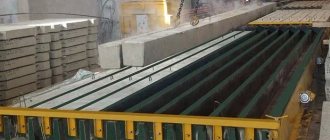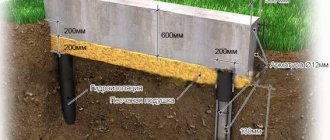In cases where the foundation for a future structure is being built in difficult soil conditions with a high risk of shifting, it is advisable to use bored piles with casing. This technology, which is recognized as one of the safest, is also used in cases where the future building is planned to be erected in an area characterized by dense buildings.
Bored pile foundation
Definition of casing
Siege pipes
The diameter of the bored rods is 0.35 - 1.5 meters, the length reaches 30 meters, this type of piles is used for high loads and in deep, stable soil layers.
The technology is used in the following conditions:
- concentrated horizontal and vertical loads;
- on construction sites with difficult engineering and geodetic conditions;
- in the case of nearby buildings.
Concrete pipes include several sections with special joints for reliable and quick connections. Concrete is loaded into the funnel from a truck mixer or an electric vibration feed hopper with a pneumatic impact device is used. The used cocoon is removed from the well after filling a given height area with concrete.
The concrete in the wellbore is compacted with a vibrator, which is mounted on the inlet funnel of the casing. After complete pouring, the pile head is formed using an inventory machine and insulated in winter. Install inclined and vertical elements using drilled shell technology. Stationary capsules are immersed with a dreiteller (rotary platform), and the extracted areas are buried and removed using a vibratory driver.
Which products are better to choose and why?
The best choice of pile type depends on:
- conditions of the construction site (characteristics of the soil base),
- type of building (house or outbuildings),
- cost of finished products.
In one case, it is better to use metal pipes and screw piles, and in another case it will be cheaper to use used reinforced concrete products. This is decided by the developer himself, weighing all these factors together.
Types of pile driving
Stages of assembling a bored pile
The piles are built according to the principle of a wall in the ground. The trunk is dug with a hydraulic grab under the protection of a bentonite mixture. Concrete does not delaminate in concrete-cast collectors and does not mix with soil fluid that occurs in passages during drilling. Concreting proceeds evenly to the bottom of the well, while the slurry comes to the surface.
Popular methods for packing pile racks:
- drilling in an inventory casing capsule;
- percussion-rope drilling;
- continuous hollow screw method;
- screwing in the casing;
- vibration immersion of a hollow column;
- excavation of soil under the protection of a clay mixture.
The widening at the bottom of the pile is done using the explosive method. The casing is installed in the finished well so that it does not reach the bottom of the passage by 1.2 - 1.5 meters. A charge of the required mass is lowered into the pipe, and the detonator is brought up to the blasting device. They explode after filling the shell with concrete, resulting in the mixture falling into the expanded lower sphere. The remainder of the space is filled to the top with concrete mixture.
What types of pile packings are there?
The use of bored piles is the most effective method of organizing a buried foundation. During the construction process, drilling is carried out to the required depth, where the pile shaft is equipped with an enlarged lower part. This makes it possible to additionally fill it with concrete mixture, soil and sand.
To obtain such a “broadening” in the lower section, the use of special drilling equipment that pushes the rock apart helps. Subsequently, the concrete mixture is compacted, for which a directed explosion can even be used to compact the rock.
To obtain cylindrical cavities in the soil, different techniques are used, which gave rise to the following classification of pile packings:
- Bored.
- Sandy.
- Soil concrete.
- Pneumatic.
- Frequently rammed.
- Vibro-rammed.
When choosing a suitable option, the main criterion has always been the type of soil at the construction site. Thanks to the advent of modern technology, the same method can now be used regardless of soil type.
Testing for the effectiveness of the method is carried out by specialists:
- The walls of the well are not strengthened.
- To strengthen the drilled shaft, a clay solution is used.
- Casing products are used.
Installation of bored piles using casing pipes
The inventory method is the use of casing capsules, buried during the process and removed after concreting.
There are different types of installation:
- pneumatically compacted rods;
- vibrorammed piles;
- frequency rammed racks.
Pneumatic compaction is used for foundations with a high level of soil liquid. The mixture is fed into the casing capsule under air pressure in small portions. The work is carried out through a pneumatic pressure airlock compartment with valves at the top and bottom for dosed supply.
Vibrotamping is used in dry places. The casing is immersed into the ground by vibration, which is equipped with a removable reinforced concrete tip at the end. The vibrator is removed, and the pipe is filled to 0.8 - 1.0 m with solution and the tamping rod is lowered. As a result, the tip is pressed into the ground and an expanded heel is obtained. The casing capsule is removed after filling with concrete.
Frequent ramming uses a casing with a cast iron shoe at the bottom. A reinforcement cage is placed in the column cavity and it is immersed under hammer blows to the desired level. As the pipe moves, it compacts the soil layers. The shell is gradually raised by vibration in parallel with the supply of the mixture, while the hammer is still compacting the concrete, and the shoe is pressed into the ground at the bottom of the passage.
Purpose of casing in wells
The casing pipe prevents the soil from falling away.
The pipe keeps the earth from falling inside the well, so the wall material is chosen correctly. The selection depends on the diameter of the pile and the physical and mechanical characteristics of the soil. Often the material is plastic or metal. The installation of bored piles using casing pipes is used in any geological situations and unstable soils.
Casing is used in the following conditions:
- unexpected changes in the thickness of dense layers;
- when cutting through massive embankments with boulders or remains of concrete and stones inside;
- in the city.
Shells up to 10 meters are installed for medium and low loads (low-rise construction). The drilling method is not used in permafrost, when aggressive soil liquids are detected or when industrial waste is exposed to the trunk in the ground.
Packed piles up to 50 meters long are installed in wet lands. Casings are placed in heterogeneous fluid soils interspersed with sandy loam and sandy layers. Casing piles up to 60 meters are installed using powerful equipment on any soil. In seismic regions, casing technology involves metal shells that are not removed after loading with concrete.
Conditions of use
The choice of the type of pile foundation is influenced by several factors, such as:
- Soil characteristics.
- Installation technology.
- Economic expediency.
Soil characteristics
These include:
- density,
- soil structure,
- heaving,
- freezing depth,
- ground water level.
If the soil structure contains many rocky inclusions, then when installing screw piles, the anti-corrosion coating of the metal may be damaged, which will significantly affect the service life of the piles. In this case, preference is given to reinforced concrete, plastic and a/c products.
The characteristics of the soil foundation are the starting point for calculating the length of the pile , and, accordingly, the length of the pipe itself.
If the calculated depth of the supports does not significantly coincide with the standard dimensions of finished reinforced concrete products and screw supports, the developer chooses plastic or a/c pipes. They can be easily cut to adjust their longitudinal dimensions.
Installation technology
In this regard, screw supports have a great advantage. Their installation does not require excavation work, which is necessary when constructing a foundation from other types of pipes.
If you plan to build light buildings, then in this case you can get by with plugging sections of water pipes.
Installation of a pile foundation made of plastic and ac pipes will require the use of land drilling technology. For shallow laying depths and small pipe diameters, a garden drill is used. In other cases, a drilling rig is rented to drill deep, large-diameter wells.
Economic expediency
The cost factor is one of the fundamental factors influencing the choice of pile type. This is especially sensitive to the total estimated cost of construction with a large number of point supports. In this case, the choice largely depends on the financial capabilities of the developer.
Advantages of drilling technology
The main positive point is the ratio of cost and reliability of the pile foundation. The foundation is a cheap and level support that can withstand up to 10 tons of pressure. Casing rods are installed in any soil, and the service life is about a century.
The advantages of bored technology with the installation of casing shells are highlighted:
- installation speed;
- year-round construction using anti-freeze additives in concrete;
- screwing in piles and filling with concrete in a densely built-up region of a metropolis without the use of heavy units;
- low noise level during operation.
For vibration and screwing, modified technical mechanisms are used, which are compactly transported and conveniently placed in a small construction site.
Rules for performing work
Drilling under the protection of a casing
When installing casing and performing packing, regulatory documents SP 24.13.330, SP 28.13.330, SP 45.13.330, as well as industry and departmental guidelines are used. For a specific case, a work execution project (WPP) and standard technology maps for the process are drawn up.
Using a drilling rig with an auger or drill, a passage of the selected cross-section and length is made. The wellhead is lined with a steel section of pipe. Widening at the bottom is carried out if it is in the project. Conduct a documentary inspection of the well after completion of drilling. A reinforcement structure is placed in the trunk to increase the load-bearing capacity. Concreting is carried out using the moving shell method, using concrete pipes. They come in straight or telescopic types.
Concrete is prepared on site in concrete mixers or delivered from the plant. The mixture is constantly shoveled until it is laid into the structure, but not more than 12 hours, otherwise the strength will decrease.
Bored piles on soils with excess groundwater content
The most rational option is the use of bored pile supports when installing foundations on unstable soils.
Due to the accessibility of the structure during well drilling, the piles are equipped with additional fixation of the walls formed by excess pressure of moisture or clay solution. The well is constructed using both impact and rotational methods. If the drill passes through hard rocks, it is advisable to use special replaceable working attachments of the impact type.
Work progress
Installation of bored pile supports with fixation of clay mortar:
- Installation of the drilling mechanism and production of the well.
- Making an expansion plane.
- Installation of a frame made of reinforcing bars.
- Installation of casing pipes.
To regulate the uncontrolled spread of extracted masses along the perimeter of the drilling rig in its direction, wooden gutters made from any available materials are installed at an angle.
During the work, a clay solution is supplied through the drill, the main purpose of which is to counteract the collapse of the soil by the hydraulic pressure created. Ultimately, with constant circulation of the composition, a clay crust forms on the side walls.
Watch the video on how to install the supports yourself.
Upon completion of the activities associated with drilling the well and cleaning the spent face, a reinforced frame is installed in the drilled well. The final stage of the VPT technology is the fixation of concrete casing pipes. Once concreting begins, the pipe is removed from the well using a method similar to that described above, and the equipped pile is subjected to molding.
In the case of using sectional structures with lifting of each of the component sections, it is necessary to disconnect the connecting clamps, thereby reducing the specific weight of the casing structure and reducing the effort to remove it.
Recommendations for working on different soils
Before installing the casing, a hole is made in the ground, so the quality of the soil is taken into account when choosing units and the type of bored pile.
Metal and plastic capsules are placed in earthen layers:
- peat soils;
- clayey soils, clays;
- sands, sandy loams;
- loams.
In watered layers, unstable, floating, subsidence soils, concreting is carried out no later than 8 hours after the well is completed. In stable categories of land, the standard start time for concreting is extended to 24 hours.
If it is not possible to lay the mixture within the specified time frame, drilling cannot begin until favorable circumstances arise. Drilling of started passages is stopped at a level of 2 m to the design level and expansion is not performed.
Choice of product diameter
To determine the cross-section of the pile, tables from GOST 10.060.0-1995 and GOST 19.804.2-1979 are used. They give the ratio of the diameter of the rod, the area of its support, and the calculated load-bearing capacity. In addition, there is information about the volume of concrete, the number of vertical reinforcing elements and the consumption of metal rods per frame.
First, loads from the object under construction are collected and the actual pressure on the pile foundation is calculated. After this, the required area of the rack base is calculated. But according to the tables, the square of the heel is removed without calculation.
Take into account the fact that the actual load using the necessary coefficients should not be greater than the calculated soil resistance. Select the appropriate value in the table and determine the diameter of the pile. Complex calculations are carried out by engineers, whom the customer contacts to find the parameters of the foundation.











